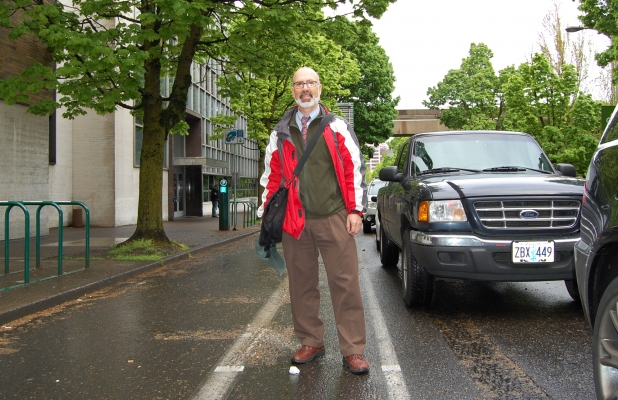Visiting scholar: bike routes as stressful as their weakest link

When Peter Furth returned from a sabbatical in the Netherlands inspired to make his home country as bike-friendly, he knew he’d encounter bicycle skeptics. What surprised him was the resistance he got from bicycle supporters.
Furth , a professor at Northeastern University and an OTREC visiting scholar, shared some of his research on low-stress bicycle networks in a talk May 4 at Portland State University. Click here for more information.
Even in recent years, bicycling advocacy organizations were dominated by followers John Forester’s concept of “vehicular cycling,” Furth said, and opposed to separated bicycle facilities. Cyclists should use the road, and be treated, like any other vehicle operators, according to this reasoning.
“People get an idea of what utopia is,” Furth said, “and their idea is just bikes operating like any other vehicle. The crazy thing is, it’s an experiment that has been lived out every day for the last 50 years. You can go out and do it today. It just doesn’t work. It’s just nutty.”
European cities have carried out their own massive experiment for decades as well, Furth said. “Millions of people every day are riding on separated facilities, and what is the outcome? Huge numbers of people riding: children, old people, men and women in equal numbers, and the bike fatality rate is 10 times lower than ours.”
The lesson from Europe — if you build separated bike facilities, people will use them safely — seemed so obvious to Furth that it shouldn’t require scientific study. But skeptics, including an engineering community that had been swayed by Forester supporters, had advanced studies that they offered as proof that separated bikeways were less safe than mixing bicycles with automobile traffic.
Undeterred, Furth set to providing evidence supporting the European model. But he knew that overseas evidence wouldn’t necessarily sway his fellow engineers. “The American engineering mentality is that Europe is the moon,” he said. But there weren’t enough examples in the United States to study.
“I decided, if nobody is going to pay attention to Europe, there is a place in North America with a bunch of separated bikeways, where nobody had studied their safety”: Montréal, Canada. Furth set up a study there and found that, sure enough, the injury rate was lower on separated bikeways than riding in the street.
Momentum has slowly turned since then, with cities across the continent adopting cycle tracks and other bikeways. There is, of course, a long way to go. Furth’s most recent research, which he presented at Portland State, details his assessment of the San Jose, Calif., bicycle network.
The key to a cycle-friendly city, Furth concluded from his experiences in Europe, was providing low-stress routes for cyclists. Whereas riding his bike in the U.S. took 100 percent concentration, that wasn’t the case in the Netherlands and elsewhere in Europe. “There, you could just ride, look at the ducks, look at the sheep, look at the old churches.
“My kids just wanted to bike all the time,” Furth said. “My wife shopped for six on a bike, and in America she won’t do it. It’s too stressful.”
Furth devised a four-level rating system for cycling stress on road segments, with the first level suitable for children, the second for most adults, and the third and fourth representing higher-stress level. This classification provides a framework to identify and address promising bike routes.
Applied to San Jose, most road segments turned out to be lower stress. Just as a chain defined by its weakest link, however, a bike route is as stressful as its worst segment. “If you only look at the low-stress segments,” Furth said, “you get islands separated by barriers. You can’t get from here to there.”
Freeways, rivers and arterial roads all provide stressful connections to otherwise decent bike routes. The good news, he said, is that overcoming the barriers is easier than creating an entire bikeway system from scratch.
“It’s not like we have to build a while rail network or network of freeways,” Furth said. “There’s a whole network there already.”
You can watch Furth’s archived presentation through the link here.
